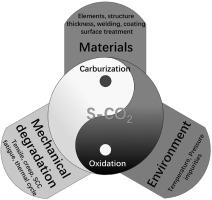Progress in Materials Science ( IF 37.4 ) Pub Date : 2023-03-06 , DOI: 10.1016/j.pmatsci.2023.101107 Kaiyang Li , Zhongliang Zhu , Bo Xiao , Jing-Li Luo , Naiqiang Zhang

|
The supercritical CO2 (S-CO2) Brayton cycle has drawn much attention in the field of thermal cycles due to its merits of high efficiency, simple layout and compact turbomachinery. Several Fe-based, Ni-based and other heat-resistant alloys are the preferred constructional materials for crucial components, but their corrosion-related degradations still hinder the broad applications of this technology. S-CO2 could induce coupled oxidation and carburization, causing undesired alloy consumption, microstructure change and rapid failure. Besides, other physical and chemical factors from both materials and S-CO2 environment sides would further complicate the corrosion process and make the material selection difficult. To reveal the degradation mechanisms and provide a guideline for selecting suitable materials, this comprehensive review elucidates corrosion-related behavior of alloys in S-CO2 environments. The effects of temperature, pressure, impurity, alloying elements & structure, sample thickness, welding, coating and surface treatments on corrosion are systematically scrutinized. In addition, stress-assisted corrosion, including tensile behavior, creep, stress corrosion cracking, fatigue and thermal cycling are also thoroughly discussed. Based on these analyses, a summarization covering related corrosion mechanisms and predicting models has been made, with an attempt at proposing the material selection strategy and providing suitable candidate materials. The future research perspectives are outlined in the end.
中文翻译:

高温超临界 CO2 环境中材料降解的最新技术概览
超临界CO 2 (S-CO 2 )布雷顿循环以其效率高、布局简单、涡轮机械紧凑等优点在热循环领域备受关注。几种铁基、镍基和其他耐热合金是关键部件的首选结构材料,但它们与腐蚀相关的退化仍然阻碍了该技术的广泛应用。S-CO 2会引起耦合氧化和渗碳,导致不希望的合金消耗、微观结构变化和快速失效。此外,材料和S-CO 2的其他物理和化学因素环境方面会使腐蚀过程进一步复杂化,并使材料选择变得困难。为了揭示降解机制并为选择合适的材料提供指导,这篇综合综述阐明了合金在 S-CO 2中的腐蚀相关行为环境。系统地研究了温度、压力、杂质、合金元素和结构、样品厚度、焊接、涂层和表面处理对腐蚀的影响。此外,还详细讨论了应力辅助腐蚀,包括拉伸行为、蠕变、应力腐蚀开裂、疲劳和热循环。基于这些分析,总结了相关的腐蚀机理和预测模型,试图提出材料选择策略并提供合适的候选材料。最后概述了未来的研究前景。



























 京公网安备 11010802027423号
京公网安备 11010802027423号